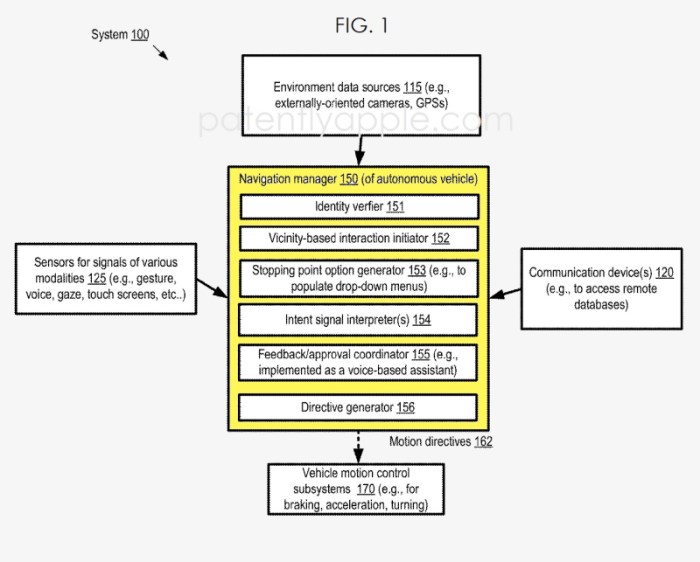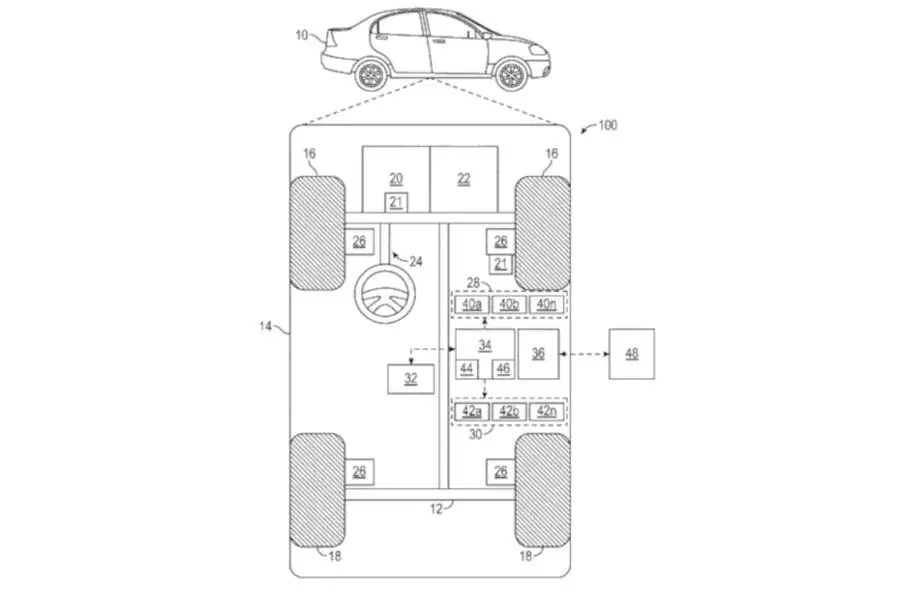Self-Driving Car Technology in Apple Patents
Apple, known for its innovative consumer electronics, has also been quietly developing self-driving car technology. The company has filed numerous patents related to autonomous vehicles, showcasing its ambition in this rapidly evolving field. While Apple’s plans for a self-driving car remain shrouded in secrecy, its patents offer valuable insights into the company’s technological prowess and its vision for the future of transportation.
Overview of Apple’s Self-Driving Car Patents
Apple’s self-driving car patents cover a wide range of technologies, from sensor systems and mapping to vehicle control and user interface. These patents highlight Apple’s focus on developing a comprehensive autonomous driving system that prioritizes safety, efficiency, and user experience.
- Sensor Systems: Apple has patented several sensor systems for autonomous vehicles, including lidar, radar, and camera technologies. These systems are crucial for perceiving the environment and detecting objects, enabling the vehicle to navigate safely.
- Mapping and Localization: Accurate mapping and precise localization are essential for autonomous driving. Apple has filed patents for advanced mapping techniques that incorporate real-time data and sensor information to create detailed 3D maps of the environment.
- Vehicle Control: Apple’s patents also cover aspects of vehicle control, including steering, acceleration, and braking. These technologies aim to ensure smooth and predictable vehicle behavior in various driving conditions.
- User Interface: Apple is renowned for its user-centric approach to technology. Its patents include concepts for intuitive user interfaces for self-driving cars, allowing passengers to interact with the vehicle and manage various functions seamlessly.
Impact of Apple’s Patents on the Future of Autonomous Vehicles
Apple’s self-driving car patents have the potential to significantly impact the future of autonomous vehicles.
- Technological Advancement: Apple’s patents showcase its commitment to pushing the boundaries of self-driving car technology. The company’s innovative solutions could contribute to advancements in areas such as sensor fusion, mapping accuracy, and vehicle control.
- User Experience: Apple is known for its focus on user experience, and its patents reflect this philosophy. The company’s efforts to develop intuitive user interfaces for self-driving cars could make autonomous vehicles more accessible and appealing to a wider audience.
- Competition and Innovation: Apple’s entry into the self-driving car market could intensify competition in the field, driving innovation and accelerating the development of autonomous vehicle technology.
Comparison with Other Prominent Players
Apple’s approach to self-driving car technology differs from that of other prominent players in the field. Here’s a comparison of Apple’s strategy with those of companies like Tesla, Waymo, and Cruise:
| Company | Focus | Approach | Key Features |
|---|---|---|---|
| Apple | Integrated system, user experience | Developing a comprehensive autonomous driving system with a focus on user-friendliness and seamless integration with Apple’s ecosystem. | Advanced sensor systems, detailed mapping, intuitive user interface. |
| Tesla | Full self-driving capabilities, electric vehicles | Developing a fully autonomous driving system for its electric vehicles, emphasizing advanced hardware and software. | Autopilot, Full Self-Driving (FSD), advanced driver assistance systems (ADAS). |
| Waymo | Robotaxis, public transportation | Developing a fully autonomous driving system for robotaxis and public transportation, focusing on safety and reliability. | Highly accurate mapping, advanced sensor fusion, extensive testing in real-world environments. |
| Cruise | Autonomous ride-hailing, urban mobility | Developing a fully autonomous driving system for ride-hailing services and urban mobility, emphasizing scalable solutions. | Highly automated vehicles, partnerships with ride-hailing companies, extensive data collection and analysis. |
Potential Applications and Impact
Apple’s navigation system patents, while initially envisioned for self-driving cars, possess a broader range of applications and potential impacts, extending beyond the automotive industry. These patents could revolutionize various aspects of our lives, from personalized navigation to enhanced safety and efficiency in diverse domains.
Applications Beyond Self-Driving Cars
Apple’s navigation system patents, with their focus on advanced mapping, real-time data processing, and user-centric design, hold significant potential for applications beyond self-driving cars.
- Enhanced Navigation for Pedestrians and Cyclists: Apple’s navigation system could be adapted to provide pedestrians and cyclists with more detailed and personalized route guidance. This could include information on accessibility, safety, and real-time traffic conditions. Imagine navigating a city with a detailed map that highlights the safest pedestrian crossings, identifies bike lanes, and adjusts routes based on real-time traffic conditions.
- Smart City Infrastructure: These patents could be leveraged to optimize traffic flow in smart cities. By integrating with traffic management systems, Apple’s navigation system could dynamically adjust routes, prioritize emergency vehicles, and optimize traffic light timings, leading to smoother traffic flow and reduced congestion.
- Augmented Reality Navigation: The technology behind Apple’s navigation system could be incorporated into augmented reality applications, providing users with real-time overlays on their surroundings. This could include navigation instructions projected onto the real world, virtual landmarks, and even dynamic updates on nearby points of interest.
- Robotics and Automation: Apple’s navigation system could be applied to robots and autonomous machines, enabling them to navigate complex environments with greater accuracy and efficiency. Imagine robots navigating warehouses, hospitals, or construction sites with advanced navigation systems, optimizing tasks and enhancing safety.
Apple’s navigation system patents have the potential to significantly impact the automotive industry and beyond.
- Competition in the Automotive Market: Apple’s entry into the automotive navigation market could intensify competition, driving innovation and advancements in navigation technologies. This could lead to more user-friendly, accurate, and feature-rich navigation systems for consumers.
- Increased Data Collection and Privacy Concerns: The use of Apple’s navigation system could lead to increased data collection about user movements and preferences. This raises concerns about privacy and data security, necessitating robust measures to protect user information.
- Transformation of Transportation Systems: Apple’s navigation system, in combination with self-driving technology, could revolutionize transportation systems. This could lead to more efficient, sustainable, and accessible transportation options, reducing traffic congestion and reliance on personal vehicles.
- Impact on Other Industries: The applications of Apple’s navigation system extend beyond transportation, impacting industries like logistics, delivery, and urban planning. These industries could benefit from improved efficiency, reduced costs, and enhanced safety.
Scenario: Everyday Impact on a User
Imagine a busy professional, Sarah, navigating a bustling city. Using Apple’s navigation system on her smartphone, Sarah receives personalized recommendations for the fastest route to work, considering real-time traffic conditions and avoiding construction zones. The system seamlessly integrates with her calendar, alerting her about an upcoming meeting and suggesting the most efficient route to arrive on time.
Sarah’s navigation system also provides real-time updates on nearby parking availability, helping her find a convenient and affordable spot. As she walks to her office, the system guides her through a pedestrian-friendly route, highlighting safe crossings and avoiding crowded areas. Throughout the day, Sarah receives alerts about traffic disruptions and alternative routes, ensuring she stays on schedule and avoids delays.
In the evening, Sarah uses the navigation system to find a restaurant based on her dietary preferences and reviews. The system guides her to the restaurant, provides real-time updates on estimated arrival time, and even suggests a convenient parking spot nearby. As Sarah enjoys her meal, the system continues to monitor traffic conditions, ensuring she can return home safely and efficiently.
This scenario illustrates how Apple’s navigation system patents could significantly impact a user’s everyday life, making navigation seamless, personalized, and efficient.
Apple’s foray into self-driving car technology, backed by its robust navigation system patents, raises significant ethical considerations that demand careful examination. As these systems become increasingly sophisticated, the potential impact on society and the automotive industry warrants a comprehensive assessment of the ethical implications and future possibilities.
Ethical Considerations in Apple’s Self-Driving Car Technology
The ethical considerations surrounding Apple’s self-driving car technology are multifaceted and encompass a wide range of issues.
- Algorithmic Bias and Fairness: Self-driving car systems rely on algorithms trained on massive datasets. If these datasets contain biases, the resulting algorithms may perpetuate these biases, leading to unfair or discriminatory outcomes. For example, an algorithm trained on data primarily from urban areas might perform poorly in rural settings, potentially leading to safety risks.
- Liability and Accountability: In the event of an accident involving a self-driving car, determining liability can be complex. Who is responsible: the driver, the manufacturer, or the software developer? This issue requires clear legal frameworks and ethical guidelines to ensure fairness and accountability.
- Privacy and Data Security: Self-driving cars collect vast amounts of data about their surroundings, including location, speed, and driver behavior. Ensuring the privacy and security of this data is paramount to protect user information and prevent misuse.
- Job Displacement: The widespread adoption of self-driving cars could lead to job displacement for professional drivers, including truck drivers, taxi drivers, and delivery personnel. Addressing this potential economic impact is crucial for a smooth transition to a future with self-driving vehicles.
- Ethical Decision-Making in Autonomous Systems: Self-driving cars face complex scenarios where they must make split-second decisions, potentially involving life-or-death situations. Developing ethical frameworks for these systems to navigate such dilemmas is a critical challenge.
Apple’s navigation system patents have the potential to significantly shape the future of the automotive industry.
- Enhanced Navigation and Route Optimization: Apple’s patents could enable more accurate and efficient navigation systems, leveraging real-time traffic data, road conditions, and user preferences to optimize routes.
- Integration with Smart City Infrastructure: Apple’s navigation systems could seamlessly integrate with smart city infrastructure, enabling communication with traffic lights, parking systems, and other connected devices for enhanced navigation and traffic management.
- Augmented Reality (AR) Navigation: Apple’s patents could pave the way for AR-based navigation systems that overlay virtual information onto the real world, providing drivers with more immersive and intuitive guidance.
- Personalized Driving Experiences: Apple’s navigation system patents could facilitate personalized driving experiences tailored to individual preferences, including music, climate control, and route suggestions based on past behavior.
Research Questions for Further Exploration
Further research is needed to address the ethical considerations and explore the potential impact of Apple’s navigation system patents.
- How can we ensure fairness and mitigate bias in the algorithms used in self-driving car systems?
- What legal and ethical frameworks are needed to establish clear accountability in the event of accidents involving self-driving cars?
- How can we balance the benefits of data collection with the need to protect user privacy and data security in self-driving cars?
- What strategies can be implemented to address potential job displacement caused by the widespread adoption of self-driving cars?
- How can we develop ethical guidelines for self-driving cars to navigate complex scenarios involving moral dilemmas?
- What are the potential implications of Apple’s navigation system patents for the development of smart cities and connected transportation systems?
Apple patent navigation system self driving cars – Apple’s navigation system patents represent a significant step towards the future of autonomous driving. As we navigate the complexities of this rapidly evolving landscape, it’s clear that Apple’s innovative approach to navigation technology will play a pivotal role in shaping the automotive industry for years to come. The potential applications of these patents extend far beyond self-driving cars, promising to transform our everyday lives in ways we can only begin to imagine.
Apple’s patent for a navigation system for self-driving cars is just one example of the tech giant’s aggressive pursuit of the future. Meanwhile, Nokia’s acquisition of Alcatel Lucent for $16.6 billion nokia to acquire alcatel lucent for 16 6 billion shows the ongoing consolidation in the telecoms industry, a sector that’s increasingly intertwined with the development of autonomous vehicles.
Both moves point to a world where our phones, our cars, and our networks are all connected in ways we’re only beginning to imagine.
 Standi Techno News
Standi Techno News

